©Partner der Lüneburger Heide GmbH
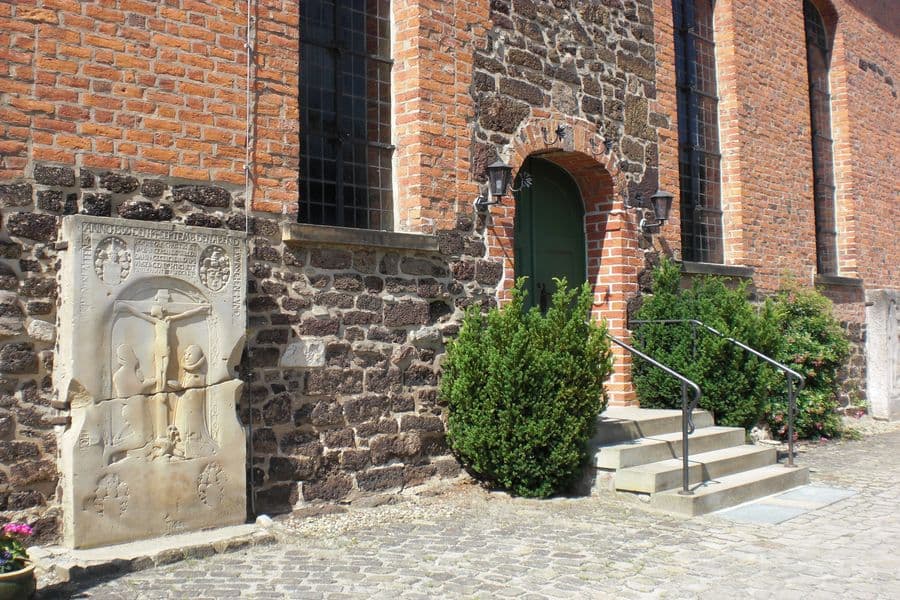
©Partner der Lüneburger Heide GmbH
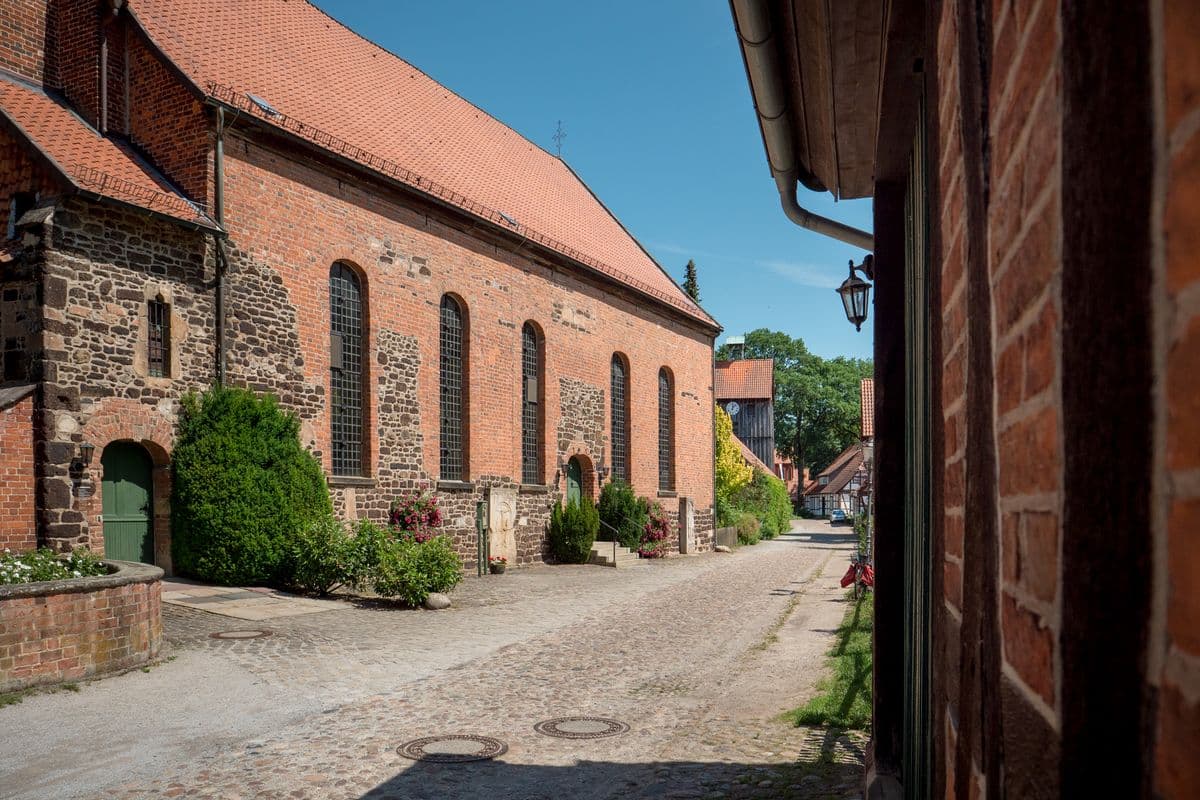
©Partner der Lüneburger Heide GmbH
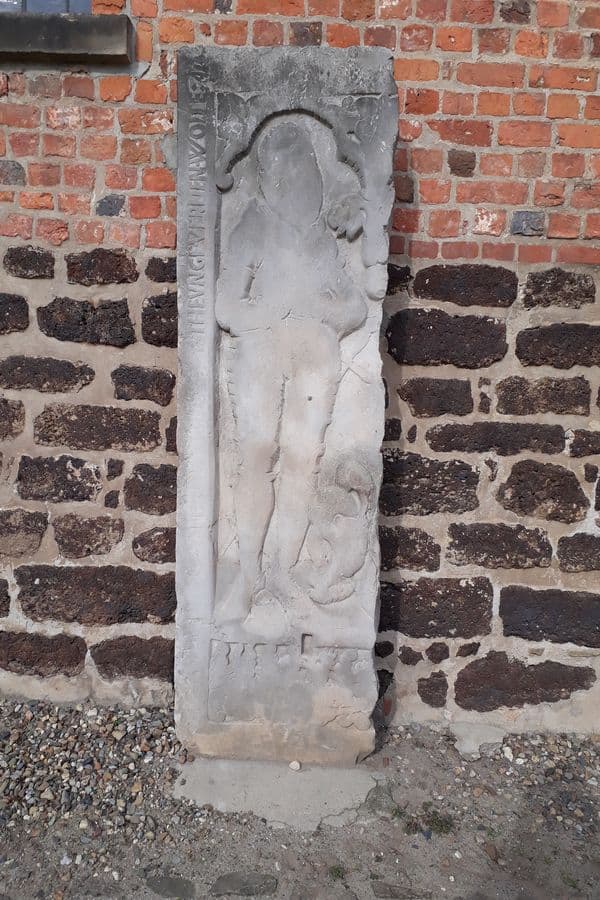
©Partner der Lüneburger Heide GmbH
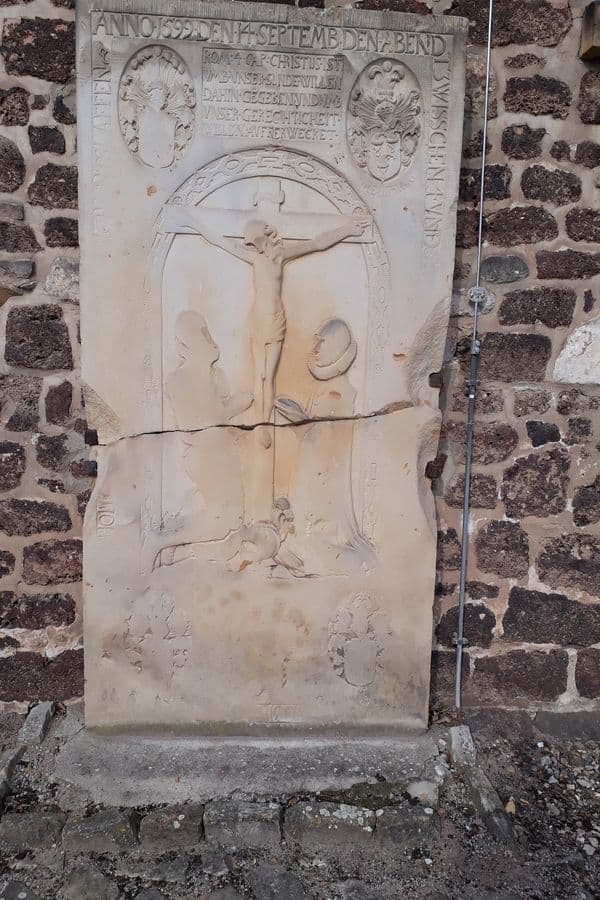
©Partner der Lüneburger Heide GmbH
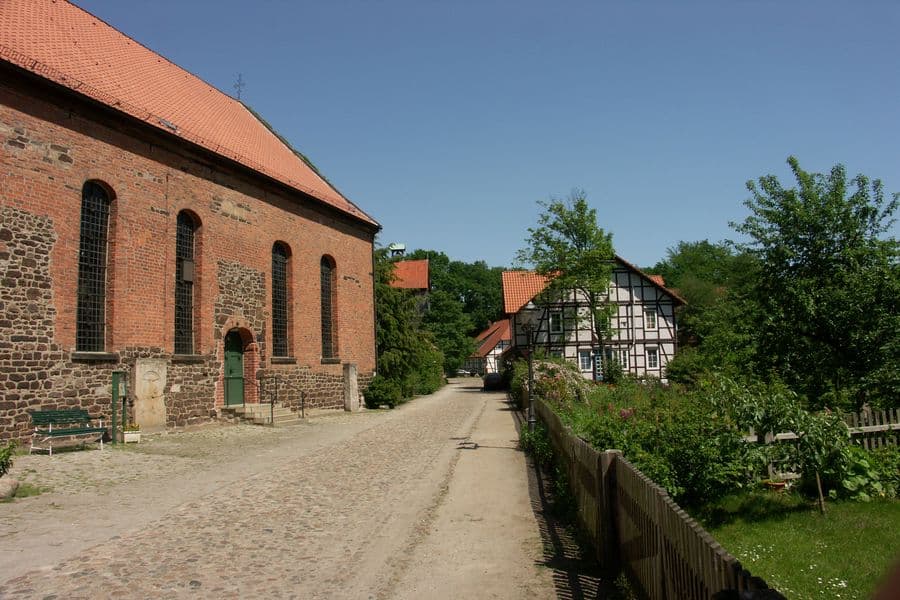
Grabplatten ‐ Stumme Zeugen an der Kirchenaußenwand‐
Zwei Grabplatten sind an der südlichen Kirchenaußenwand angebracht (rechts und links vom Haupteingang).An dieser Stelle wird die Inschrift der großen Grabplatte, die links vom Haupteingang der Kirche steht, erläutert.
Die Grabplatte ist 208 cm hoch und 119 cm breit , in der Mitte gebrochen und im unteren Teil stark abgetreten. Es handelt sich um die Grabplatte einer Frau von Meltzing, Ehefrau eines Herrn von Mahrenholtz. Sie ist am 14. Sept. 1599 verstorben. Im Innenfeld ist deutlich ein Kreuz zu erkennen. Darunter kniend ein Ehepaar.
In den vier Ecken befinden sich Wappen, wobei nur noch das obere rechts in Umrissen einigermaßen gut erkennbar ist. Darunter steht der Name „Meltzing“. Links befindet sich das Wappen Mahrenholtz mit den sieben Pfauenfedern.Zwischen den beiden oberen Wappen steht der Text: „Christus ist um unser Sünde willen dahin gegeben und um unser Gerechtigkeit Willen auferwecket.“
Die Randbeschriftung oben und an den Seiten kann nur unvollständig wieder gegeben werden: „Anno 1599 den 14 Septembris den Abendt zwischen 4 und 5….. Eltzin ….Holt ….Elich … Entslafen …. Meltzing.“
Anmerkung: Die Inschrift lässt sich so deuten„: Im Jahre 1599 den 14. September den Abend zwischen vier und fünf selig entschlafen.“ Bei der Verstorbenen muss es sich den Wappen zufolge um eine Tochter des zu Hollenstedt und Emmendorf ansässigen
Heinrich von Meltzing und der Clara von Weckstern und um eine Tante der Ebstorfer Äbtissin Lucia von Appel handeln. Der Sterbefall von 1599 lässt sich in den hiesigen Kirchenbüchern nicht nachweisen, da diese erst Mitte des 17. Jahrhunderts beginnen.
Alte Nachrichten von Wienhausen
‐ Stumme Zeugen an der Kirchenaußenwand‐
Besitzverzeichnisse; Erheben von Einnahmen, Bestreiten von Ausgaben sowie
12 u. 76. – „Heimathskunde der Kirchengemeinde Wienhausen“ von 1901 von
W. Bettinghaus; III. Theil, S. 41. – Faltblatt der „Evangelisch‐lutherischen St.
Marien‐Kirche zu Wienhausen“. – „Inschriftenkatalog Lüneburger Klöster“ von
Dr. Sabine Wehking. – „Wathlingen – Geschichte eines nieders. Dorfes“ von
Heinrich Pröve von 1985. – Eine „Kote“ war das Wohnhaus eines Kötners. Im
Regelfall hatten sie weniger als eine „Hufe“; ist ein altes Landmaß, etwa 15 – 20 Morgen, so H. G. Röhrbe in in „Quellenbegriffe des 16. bis 19. Jahrhunderts“).
‐ Stumme Zeugen an der Kirchenaußenwand‐
Die St. Marien‐Kirche der Kirchengemeinde Wienhausen ist im Wesentlichen das Produkt dreier verschiedener Bauperioden: einer romanischen, einer gotischen und einer barocken.
Die Anfänge der Kirche reichen in das erste Jahrtausend zurück. Urkunden von 1051 und 1057 belegen dies.
Noch im 17. und 18. Jahrhundert haben in der Kirche Bestattungen stattgefunden. Die teilweise bis zur Unkenntlichkeit abgetretenen Grabplatten befinden sich in den Gängen zwischen den Gestühlreihen. Es sind nur noch wenige Grabplatten zu entziffern. Wollte jemand einen Angehörigen in der Kirche bestatten lassen, musste man zuvor um die Erlaubnis der Kirchen‐Kommission, dem Pastor und den Kirchenjuraten bitten. Für den angewiesenen Platz zahlte man eine sehr hohe Gebühr.
Zwei Grabplatten sind an der südlichen Kirchenaußenwand angebracht (rechts und links vom Haupteingang). Auch diese sind schwer identifizierbar. An dieser Stelle wird die Inschrift der großen Grabplatte, die links vom Haupteingang der Kirche steht, erläutert.Die Grabplatte ist 208 cm hoch und 119 cm breit , in der Mitte gebrochen und im unteren Teil stark abgetreten. Es handelt sich um die Grabplatte einer Frau von Meltzing, Ehefrau eines Herrn von Mahrenholtz. Sie ist am 14. Sept. 1599 verstorben. Im Innenfeld ist deutlich ein Kreuz zu erkennen. Darunter kniend ein Ehepaar.
In den vier Ecken befinden sich Wappen, wobei nur noch das obere rechts in Umrissen einigermaßen gut erkennbar ist. Darunter steht der Name „Meltzing“. Links befindet sich das Wappen Mahrenholtz mit den sieben Pfauenfedern.Zwischen den beiden oberen Wappen steht der Text: „Christus ist um unser Sünde willen dahin gegeben und um unser Gerechtigkeit Willen auferwecket.“Die Randbeschriftung oben und an den Seiten kann nur unvollständig wieder gegeben werden: „Anno 1599 den 14 Septembris den Abendt zwischen 4 und 5….. Eltzin ….Holt ….Elich … Entslafen …. Meltzing.“
Anmerkung: Die Inschrift lässt sich so deuten„: Im Jahre 1599 den 14. September den Abend zwischen vier und fünf selig entschlafen.“ Bei der Verstorbenen muss es sich den Wappen zufolge um eine Tochter des zu Hollenstedt und Emmendorf ansässigen
Heinrich von Meltzing und der Clara von Weckstern und um eine Tante der Ebstorfer Äbtissin Lucia von Appel handeln. Der Sterbefall von 1599 lässt sich in den hiesigen Kirchenbüchern nicht nachweisen, da diese erst Mitte des 17. Jahrhunderts beginnen.
Anmerkung:Kirchenjurat war ein gewählter oder bestellter Vertreter der Kirchengemeinde, der mit dem Pfarrer gemeinsam folgende Aufgaben wahrnahm:
Beaufsichtigung des Vermögens der Kirchengemeinde; Führen derBesitzverzeichnisse; Erheben von Einnahmen, Bestreiten von Ausgaben sowie
Buchführung darüber (so Wikipedia).
Das Geschlecht „von Mahrenholtz“ war im Flotwedel auch in Bockelskamp vertreten. Sie besaßen dort einen Hof und drei Koten als Lehen. In Wathlingen und Klein‐Eicklingen (heute Gutshof Pröve) hatten sie adlige Güter. Und im Kapitelsaal im Kloster Wienhausen tragen einige Wappenscheiben den Namen (Moritz von Marnholte, Hans von Marnholte). Eine Olgard von Mahrenholz war in Wienhausen Äbtissin von 1405– 1422. Die Klosterchronik nennt über 15 Jungfern mit Nachnamen Mahrenholtz, Mahrenholte bzw. Marenholt. Aber auch in den Ortschaften Boye oder Ahnsbeck findet man den Namen „von Mahrenholtz.“
(Quellen: „Die Kunstdenkmale des Landes Niedersachsen“; Band 34, Teil II: S.12 u. 76. – „Heimathskunde der Kirchengemeinde Wienhausen“ von 1901 von
W. Bettinghaus; III. Theil, S. 41. – Faltblatt der „Evangelisch‐lutherischen St.
Marien‐Kirche zu Wienhausen“. – „Inschriftenkatalog Lüneburger Klöster“ von
Dr. Sabine Wehking. – „Wathlingen – Geschichte eines nieders. Dorfes“ von
Heinrich Pröve von 1985. – Eine „Kote“ war das Wohnhaus eines Kötners. Im
Regelfall hatten sie weniger als eine „Hufe“; ist ein altes Landmaß, etwa 15 – 20 Morgen, so H. G. Röhrbe in in „Quellenbegriffe des 16. bis 19. Jahrhunderts“).
Recherche sowie Verfasser des Textes ist Bernhard Meißner, Wienhausen
